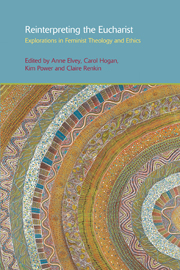Book contents
- Frontmatter
- Contents
- List of Illustrations
- Foreword
- Acknowledgements
- Contributors
- 1 Introduction
- 2 Eucharistic Metamorphosis: Changing Symbol, Changing Lives
- 3 The Sunday Eucharist: Embodying Christ in a Prophetic Act
- 4 How Australian Aboriginal Christian Womanist Tiddas (Sisters) Theologians Celebrate the Eucharist
- 5 Women, Eucharist, and Good News to All Creation in Mark
- 6 Rediscovering Forgotten Features: Scripture, Tradition and Whose Feet May Be Washed on Holy Thursday Night
- 7 Mystery Appropriated: Disembodied Eucharist and Meta-theology
- 8 Real Presence: Seeing, Touching, Tasting: Visualizing the Eucharist in Late Medieval Art
- 9 Embodying the Eucharist
- 10 Living One for the Other: Eucharistic Hospitality as Ecological Hospitality
- Subject Index
- Name Index
8 - Real Presence: Seeing, Touching, Tasting: Visualizing the Eucharist in Late Medieval Art
- Frontmatter
- Contents
- List of Illustrations
- Foreword
- Acknowledgements
- Contributors
- 1 Introduction
- 2 Eucharistic Metamorphosis: Changing Symbol, Changing Lives
- 3 The Sunday Eucharist: Embodying Christ in a Prophetic Act
- 4 How Australian Aboriginal Christian Womanist Tiddas (Sisters) Theologians Celebrate the Eucharist
- 5 Women, Eucharist, and Good News to All Creation in Mark
- 6 Rediscovering Forgotten Features: Scripture, Tradition and Whose Feet May Be Washed on Holy Thursday Night
- 7 Mystery Appropriated: Disembodied Eucharist and Meta-theology
- 8 Real Presence: Seeing, Touching, Tasting: Visualizing the Eucharist in Late Medieval Art
- 9 Embodying the Eucharist
- 10 Living One for the Other: Eucharistic Hospitality as Ecological Hospitality
- Subject Index
- Name Index
Summary
The Eucharist wherein Christ's flesh became real and available to the worshipper as a ‘real presence’ stood at the centre of religious life in the later Middle Ages. Throughout this period the wafer of bread, which miraculously becomes the body of Christ, symbolized the Eucharist. The procession held in European towns and cities on the feast of Corpus Christi reminds us of the paradoxical nature of many aspects of eucharistic devotion. A tiny disc of unleavened bread is asked to carry an almost impossibly heavy theological and spiritual burden.
The purpose of this essay is not to rehearse the complex history of the controversies and debates that developed around the emergence in the Middle Ages of the doctrine of Real Presence. Visual imagery supplies works of alternative imagination about the Eucharist. Some of the visual works challenge clerically controlled views and practices of the late Middle Ages. Indeed some images suggest that their viewers experienced ‘real presence’ outside formal liturgy. I wish to probe several of the contradictions surrounding late medieval men and women's potential imaginings of the Eucharist. The Mass of course remained the primary site for sacramental reception of the host. However, visual images, in particular ones which featured female saints, hint at more diverse, non-sacramental avenues which met the late medieval hunger for union with Christ. This essay aligns visual images, which bear an open-ended potential for meaning, with medieval texts. The comparison of images with text does not imply a crude contrast between open and closed systems of meaning. On the contrary, it is not the texts themselves (or for that matter the visual images) that lack multiple meanings, but rather the narrow way in which historians and theologians have sometimes interpreted texts without due sensitivity to historical context.
- Type
- Chapter
- Information
- Reinterpreting the EucharistExplorations in Feminist Theology and Ethics, pp. 130 - 151Publisher: Acumen PublishingPrint publication year: 2012



